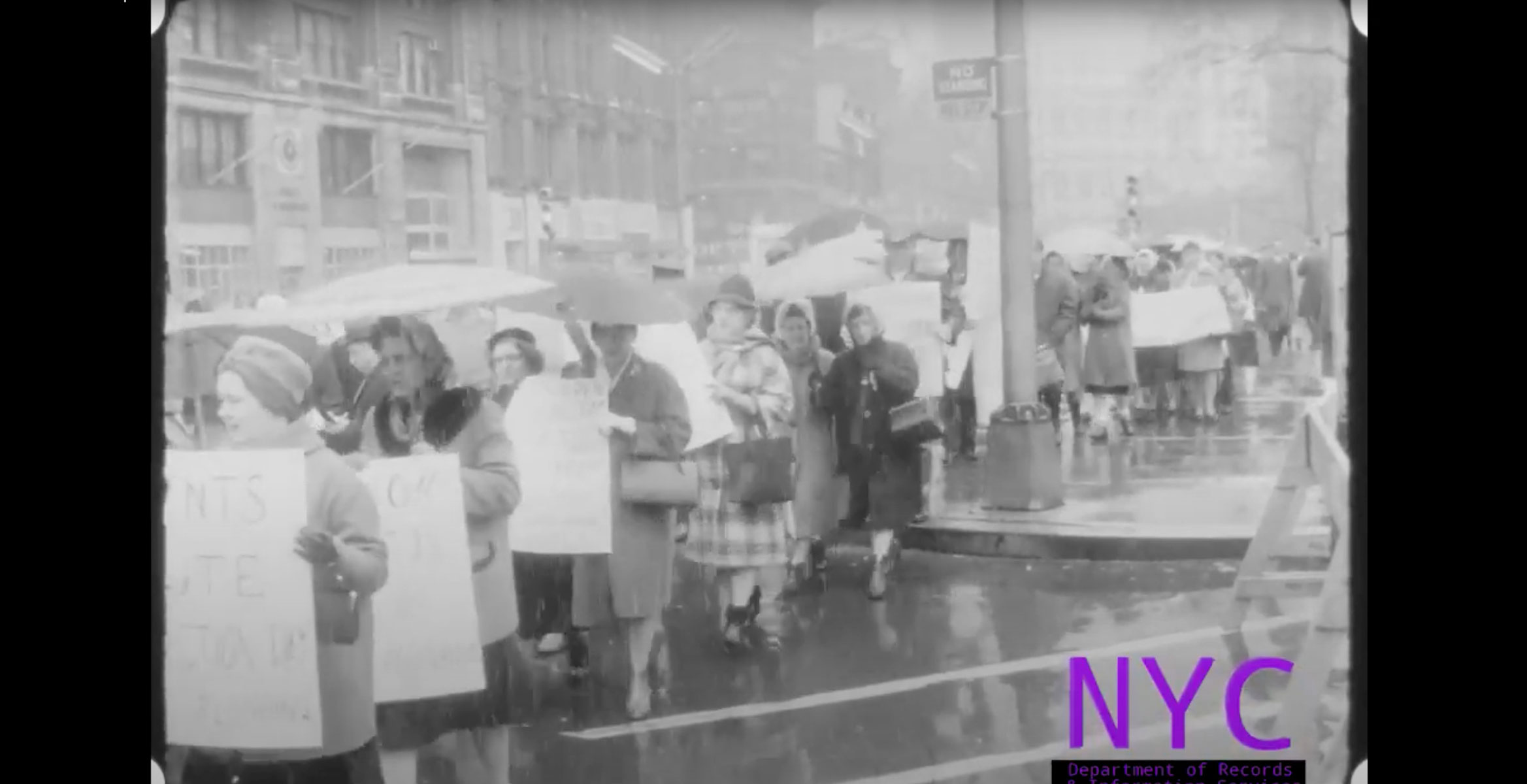Parents and Taxpayers March to City Hall on Film

Date: Mar 12, 1964
Caption: A group of white parents calling themselves “Parents and Taxpayers” led a march near City Hall to protest desegregation efforts.
On March 12, 1964 - between the first 1964 pro-integration boycott and the second - a group of white parents calling themselves “Parents and Taxpayers” led a march from the Board of Education building in Brooklyn to City Hall in Manhattan. White parents had organized and protested in favor of segregation earlier, as in the 1959 boycotts. This time, Parents and Taxpayers used many of the same protest tactics that civil rights activists used: marches and boycotts. They also claimed that they had to act to protect their rights, which they thought were threatened by desegregation plans. The name they chose for their group is important to notice. As historian Matthew Delmont has observed, by calling themselves Parents and Taxpayers, “these white protestors made an implicit claim that they occupied a higher level of citizenship than Black and Puerto Rican New Yorkers who were also parents and taxpayers.”1
Although it was a very cold and wet day, as the silent film recorded by the New York Police Department shows, thousands of white parents, mostly mothers, made the march. They can be seen, through the fog, making their way across the Brooklyn Bridge.
Some of the signs included:
- We are against busing to any neighborhood
- No Bus No Fuss
- Fight Transfers. Do not submit
- PAT Rather fight than switch [schools]
- Jackson [Heights] PTA says preserve our neighborhood school
- The Board of Education is out of its head
- Neighborhood Schools for Neighborhood Children
This footage helps us see this moment in history. But it was not created for this purpose. According to the New York City Municipal Archives, this footage was recorded as part of the New York City Police Department’s surveillance program. “Throughout the 20th century, the New York City Police Department (NYPD) conducted overt [or visible] and covert [or hidden] surveillance on groups and individuals identified as potential security threats to the City… The subjects include a broad range of political activist groups and events from 1960 to 1980.”2 That “broad range” includes many activists of color who were challenging racism and other kinds of injustice. The NYPD filmed protests against police brutality, against the Vietnam War, against racism in hiring construction workers, and more. The police perceived these activists, including the school boycotters, as “potential security threats.” That is one example of how Black and Latinx people, and those white people in solidarity with them, have been “criminalized” - or understood as criminals - in the US.3 In the NYPD surveillance films, it is unusual to see white people, and especially white women, engaged in political protest as they are here.
-
Matthew Delmont, Why Busing Failed: Race, Media, and the National Resistance to School Desegregation (Oakland: University of California Press, 2016). See also: Matthew Delmont, Why Busing Failed, accessed April 10, 2024, whybusingfailed.com. ↩︎
-
NYPD Surveillance Films, NYC Municipal Archives Collection, New York City Departments of Records and Information Services, accessed February 7, 2023, https://nycma.lunaimaging.com/luna/servlet/NYCMA
33. ↩︎ -
Elizabeth Hinton, From the War on Poverty to the War on Crime: The Making of Mass Incarceration in America (Cambridge, MA: Harvard University Press, 2016). ↩︎
Categories: parent activism, K-12 organizing, Queens, Manhattan
Tags: racist segregation, women's activism, policing and the criminal legal system, protest, white people, photography, imagery, and visual representation
This item is part of "Responding to the 1964 Boycotts" in "Boycotting New York’s Segregated Schools"
Item Details
Date: Mar 12, 1964
Creator: New York Police Department Surveillance Unit
Source: Municipal Archives of the City of New York, NYPD Surveillance Films
Copyright: Under copyright. Used with permission. Courtesy of the Municipal Archives, City of New York
How to cite: “Parents and Taxpayers March to City Hall on Film,” New York Police Department Surveillance Unit, in New York City Civil Rights History Project, Accessed: [Month Day, Year], https://nyccivilrightshistory.org/gallery/parents-and-taxpayers-march.
Questions to Consider
- What do you notice about the video? What do you wonder?
- Why do you think the marchers chose to carry flags?
- What terms do you see on the protesters’ signs? Where have you seen references to “neighborhood schools” in other documents? What did it mean to talk about “neighborhood schools” when many neighborhoods were racially segregated through policies like redlining?
- What difference does it make, to you as a viewer, to know that this footage was recorded by the New York Police Department? How does that affect what we can learn from it? How do you think the participating students and adults would have felt, if they knew they were being recorded by the police? How do you think white parents and young people might have responded, as compared to Black and Puerto Rican parents or young people?
References
How to Print this Page
- Press Ctrl + P or Cmd + P to open the print dialogue window.
- Under settings, choose "display headers and footers" if you want to print page numbers and the web address.
- Embedded PDF files will not print as part of the page. For best printing results, download the PDF and print from Adobe Reader or Preview.
